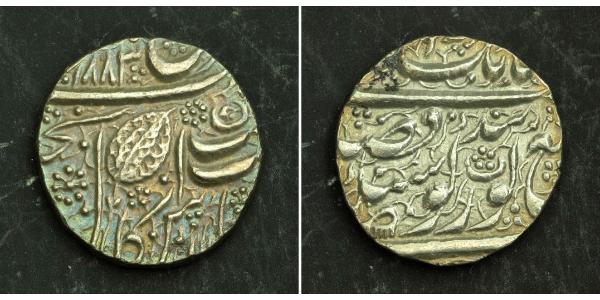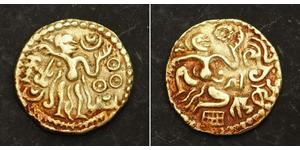(продана за $97.0)
1826, India, Sikh Empire, Maharaja Ranjit Singh. Silver Rupee Coin. aXF!
Mint Place: Amritsar
Denomination: Rupee
Mint Year: 1826 AD (VS 1883)
Maharaja: Mummadi Krishnaraja Wodeyar
Condition: Softly struck obverse, minor deposits, otherwise about XF!
Reference: Wiggins & Goron Type VI, Herrli 01.07.04., KM-20 var. (this date not listed!)
Weight: 11.10gm
Diameter: 24mm
Material: Silver
Obverse: Mint and date (1883) formula with pipal leaf in field.
Reverse: Herrli Nanakshahi couplet V. Symbol in field.
The Sikh Empire was a major power in the Indian subcontinent, that arose under the leadership of Maharaja Ranjit Singh who established a secular empire basing it around the Punjab. The empire existed from 1799, when Ranjit Singh captured Lahore, to 1849 and was forged on the foundations of the Khalsa from a collection of autonomous Sikh misls. At its peak in the 19th century, the Empire extended from the Khyber Pass in the west to western Tibet in the east, and from Mithankot in the south to Kashmir in the north. It was the last major region of the subcontinent to be conquered by the British.
The foundations of the Sikh Empire can be traced to as early as 1707, the year of Aurangzeb's death and the start of the downfall of the Mughal Empire. With the Mughals significantly weakened, the Sikh army, known as the Dal Khalsa, a rearrangement of the Khalsa inaugurated by Guru Gobind Singh, led expeditions against them and the Afghans in the west. This led to a growth of the army which split into different confederacies or semi-independent misls (from a Persian word that means 'similar'). Each of these component armies controlled different areas and cities. However, in the period from 1762 to 1799, Sikh commanders of the misls appeared to be coming into their own as independent warlords.
The formation of the empire began with the capture of Lahore, by Ranjit Singh, from its Afghan ruler, Zaman Shah Durrani, and the subsequent and progressive expulsion of Afghans from the Punjab and the unification of the separate Sikh misls. Ranjit Singh was proclaimed as Maharaja of the Punjab on 12 April 1801 (to coincide with Vaisakhi), creating a unified political state. Sahib Singh Bedi, a descendant of Guru Nanak, conducted the coronation. Ranjit Singh rose to power in a very short period, from a leader of a single misl to finally becoming the Maharaja of Punjab. He began to modernise his army, using the latest training as well as weapons and artillery. After the death of Ranjit Singh, the empire was weakened by internal divisions and political mismanagement. Finally, by 1849 the state was dissolved after the defeat in the Anglo-Sikh wars.
The Sikh Empire was divided into four provinces: Lahore, Multan, Peshawar, and Kashmir from 1799 to 1849.
Maharaja Ranjit Singh (13 November 1780 – 27 June 1839) was the founder of the Sikh Empire, which came to power in the Indian subcontinent in the early half of the 19th century. The empire, based in the Punjab region, existed from 1799 to 1849. It was forged, on the foundations of the Dal Khalsa, under the leadership of Ranjit Singh from a collection of autonomous Sikh Misls. Ranjit Singh was succeeded by his son, Kharak Singh.

|
Добавив:
anonymous 2015-10-08 |
990 монет було додано з 2025-05-21 по 2025-05-28
Одна з них:
2 Stuiver Нідерланди Срібло
в групі 2 монет / 2 цін
⇑























